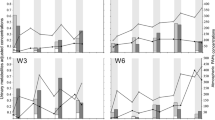Abstract.
Objectives: The aims of this study were to determine external and internal polycyclic aromatic hydrocarbon (PAH) exposure in a coke plant and to contribute to the evaluation of biological limit values. Methods: Personal air sampling was carried out on a study population of 24 coke plant workers. In detail, 16 PAHs were determined, among them phenanthrene, pyrene and benzo[a]pyrene. For the determination of internal exposure, post-shift urine samples from the workers were examined for hydroxylated metabolites of pyrene (1-hydroxypyrene, 1-OHP) and phenanthrene (1-, 2+9-, 3-, 4-hydroxyphenanthrene, 1-, 2+9-, 3-, 4-OHPhe). In both cases, approved HPLC methods were used. Results: The workers were classified into three groups. The group most exposed was that on the topside of the coke oven, with a mean value of 491.2 µg/m3 for the sum of all sixteen PAHs. The mean value at the bench side was 26.61 µg/m3, while it was 76.18 µg/m3 in the group of workers with no dedicated location (=complete area). Both the excretion of 1-OHP and the sum of hydroxyphenanthrenes had the highest mean levels in the topside group of workers (mean: 19.70 µg/g creatinine (crea.) and 39.18 µg/g crea.), followed by the bench-side workers (mean: 7.01 µg/g crea. and 12.95 µg/g crea.) and the whole-area workers (mean: 3.57 µg/g crea. and 8.70 µg/g crea.). The concentrations of all urinary metabolites correlated significantly with benzo[a]pyrene (BaP) in the air. Conclusions: According to these correlations, urinary concentrations of 8 and 11 µg 1-OHP/g crea., respectively 16 and 23 µg/g crea. for the sum of hydroxyphenanthrenes, correspond to BaP concentrations in air of 2 and 5 µg/m3, the German technical guiding concentration (TRK value). Our results are in line with others reported in the literature. That means that it should be possible today to define a standard of occupational hygiene and medicine in coke plants using the elimination of hydroxyphenanthrenes and hydroxypyrene in urine as markers for internal PAH exposure.
Similar content being viewed by others
Author information
Authors and Affiliations
Additional information
Electronic Publication
Rights and permissions
About this article
Cite this article
Strunk, .P., Ortlepp, .K., Heinz, .H. et al. Ambient and biological monitoring of coke plant workers – determination of exposure to polycyclic aromatic hydrocarbons. IAOEH 75, 354–358 (2002). https://doi.org/10.1007/s00420-001-0305-1
Received:
Accepted:
Issue Date:
DOI: https://doi.org/10.1007/s00420-001-0305-1




